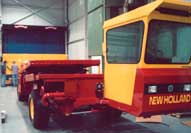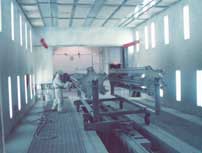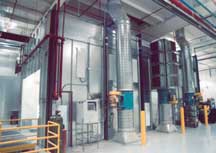Class-A Finishing for Farm Equipment


Although the merger is expected to save money in the long run, one of the challenges was to make the consolidation profitable in the short run by minimizing the cost of implementing the changes. Consequently, CNH project managers were under heavy pressure from upper management to find creative and cost-effective ways to complete the merger.
One of the consolidations was the relocation of the hay and forage product line from Grand Island, NE, to Belleville, PA. The hay and forage line would replace Belleville's skid steer loader production but would permit both the New Holland and Case IH combine lines to be produced at the Grand Island plant.
Hay and forage products include windrowers, rakes, tedders and discmower conditioners. The largest product is an automatic bale wagon that weighs 15,000 pounds and measures 31 feet long, 10 feet wide and 10 feet high. This self-propelled machine can quickly clear a baled field by automatically picking up square hay bales, mathematically arranging them on the machine bed and then off-loading the bales in tiers to create stacks up to 14 feet high.
To minimize the impact of introducing the hay and forage line in Belleville by avoiding re-engineering, CNH decided to keep the painting process consistent with the process practiced at the Grand Island facility, which is liquid spray after assembly. Because of limited floor space and an existing liquid paint system at Belleville was running at maximum capacity painting front end loaders and rakes, CNH decided a new paint system was required to paint the hay tools. A new addition to an existing building would also need to be constructed to house the equipment.
Coordinating system-relocation schedules and maintaining control of tight construction budgets was a major concern for the CNH project managers who were faced with the complicated task of combining facilities in the midst of a worrisome soft economy. To allow CNH managers to concentrate on other aspects of the transition project, CNH engaged Herr Industrial, a turnkey paint systems house, to design and build the system as well as act as project manager for the building contracts.
The project manager typically would not be the same company as the designer/builder of the system, says Barry McCarl, a manufacturing engineer with CNH. "But we had a history with Herr from when we put in a powder coating system in 1994. We went with the same approach this time."
2K urethane system
Powder coating was considered (skid steer loaders are powder coated) but not pursued because of the need to paint after assembly, the complex part geometry and the presence of wires, hoses and other heat-sensitive components. "On a scale of one to 10, the part geometries are closer to a 10," McCarl says.Therefore, a two-component urethane system was selected to achieve the Class-A finish CNH Global now requires for all of its products. The urethane system (the company had employed an alkyd system at the Grand Island plant) meets stringent salt spray requirements, has high gloss retention and durability, hardness out of the oven and better chemical resistance.
"The Class-A finish is basically an automotive-quality surface," McCarl says. "You don't want any flaws at all. The market's going in that direction, and we need to stay competitive." Though it's farming equipment, consumers in farming want to see a quality finish when they go to the dealership, just like car buyers. Not every farmer will keep the equipment shiny-like car buyers-but they want to take it home that way.
If there is a drawback to the two-component system, it's the one-hour potlife. When the line initially started up, there was some hardening of the paint in the lines as the operators got used to the system. "But that's not a problem now," McCarl says. "We circulate the paint and flush the lines on a regular basis." The guns will flush automatically if they aren't used within the one-hour potlife of the paint.
The new paint system also requires that more paint is wasted and more solvent is used. "But we're reducing that waste as we get better at loading the line and reducing the amount of flushes we go through," McCarl says.
This means more VOCs to contend with. Abatement was considered but, instead, the company is working on reducing the amount of VOCs and HAPs in the paint from 3.2 pounds of VOCs per gallon of paint to 2.8 pounds per gallon. CNH's Bellville plant has an annual emissions permit of 100 tons of VOCs. CNH is pushing that limit now because of the new product line brought in and a significant increase in orders.
In-floor tow conveyor, customized carts
The new painting process begins by loading fabricated parts and assemblies onto carts that were custom-designed for CNH's parts and the in-floor tow conveyor system. The cart consists of a structural steel frame resting on heavy-duty swivel wheels. To save capital costs, the cart was designed to be "universal" in that it can be used with any of the myriad of hay tools, regardless of shape or size. Fixtures specific to the individual products can be mounted on any cart and bolted tight.Most carts will carry a single mainframe part for a self-propelled windrower or bale wagon, or other large assemblies. "In some cases we have what we call ‘miscellaneous' carts, on which we'll place 20 to 30 of the same type of part," McCarl says.
Because several of the products are large enough to extend over the cart sides, a treadle-type control extends out from the cart frame and allows the operator to engage the tow pin without getting beneath the part. The in-floor tow conveyor operates in an index fashion that moves the carts ahead to the next position when the station process is complete and the next station is vacant. This usually occurs about every 15 minutes.

Customized pretreatment
The carts first travel from the load stations to a stainless steel pre-wash enclosure-"like a car-wash," McCarl says-where excess materials are removed from the parts, including the many hard-to-reach areas, by a single operator. The enclosure is equipped with bright lighting, ventilation, an under-floor drain and a gas-fired, high-pressure hand-wand wash unit.Following pre-wash, the product is automatically transported to the first zone of a unique, two-zone, five-stage washer. In the first zone, products go through a combination cleaner/iron-phosphate coating stage followed by a fresh-water rinse. In the second zone, products are rinsed, followed by another rinse, a nonchrome sealer stage and a final fresh-water rinse. PPG (Pittsburgh) supplies the pretreatment chemicals; Herr supplied the pretreatment equipment.
"It's unique because we have split off the cleaner/coater from the seal stage," McCarl says. "Usually batch washers only have one zone. We do that to keep the chemistry separate, to avoid contamination between the cleaner/coater and the non chrome seal."
The washer design provided significant capital cost savings compared to a conventional washer design. Washing the product in-place kept the overall machine length to 80 feet by eliminating the extensive drain area necessary for a 35-foot-long part. A comparable continuous washer would require up to 250 feet and result in a significantly larger building and higher cost.
The washer features corrosion-resistant, rapid roll-up doors at the entrance, exit and between zones that open to permit the product to enter and exit. When in place in the first zone, the first-stage spray pump starts and the risers move back and forth, driven by a pneumatic cylinder. When washing is complete, the pump shuts off and the product drains.
A PLC-controlled shuttle beneath the drain piping returns sprayed solutions to the correct tank. When draining is complete, the second-stage pump starts and uses the same moving risers to rinse the part. The shuttle then moves and returns sprayed water to the stage-two tank. This same process is repeated in the second zone for stages three, four and five. Spray and drain times are adjustable with a touch-screen menu.
To eliminate structural steel and allow the tanks to be located in the "open air" rather than beneath the housing, a drainage system was built into the concrete plant floor and directed to tanks located in a pit. The pit is situated along an outside building wall and incorporated into the facility's topography to allow for outside grade-level fork-truck access to the washer tanks for chemical delivery and maintenance.
After washing, the product is transported to a high-velocity, gas-fired dry-off oven, where temperatures don't exceed 200°F because many of the parts are heat-sensitive. Capital savings were realized because the oven design reduced the oven length to just a few feet more than the length of the longest part. Insulated roll-up doors permit the product to enter and exit. After selecting and completing the drying period, typically 15 minutes, from a PLC menu, the product automatically proceeds to a cooling and masking area.

Dry-filter paint booths
After masking, the parts enter a down-draft, dry-filter primer booth, typically manned by a single operator and containing two spray guns. The equipment in the Col-Met Spray Booths (Garland, TX) booth, including the guns, was supplied by Graco (Minneapolis) and sprays paint supplied by PPG (Pittsburgh).Parts typically take about 15 minutes in the primer booth before entering a flash-off zone, where they remain for another 15 minutes. They then move to the topcoat booth, where several painters take about 15 more minutes in a booth similar to the primer booth. Another 15-minute flash-off period follows.
After careful analysis of the expected paint usage and resulting filter change frequency, CNH opted to utilize customized dry-filter-style paint spray booths in place of more expensive water-wash booths. The high particulate removal efficiency offered by dry-filters was an additional benefit.
In the past, existing water wash booths at the plant have allowed paint solids out of the stack unless painstaking cleaning of the plenum was practiced. A down-draft design was selected to allow multiple painters to paint simultaneously and to assure an efficient, even and downward flow of air to collect overspray. The ease and frequency of changing filters drove the design of the filter plenums.
Two sets of filters are used. The primary filters are changed several times per week, while secondary bag filters are changed less frequently. Both sets of filters are mounted on filter frames arranged vertically in an 8-foot-high filter room located beneath the booth floor. The filter room is accessible by a stairway and the filters are changed much the same as they are for a cross-draft style booth. Each booth is supplied with air from a dedicated air make-up unit located on the building's roof.
An access pit was placed in the booth floor to allow the bottom of the part to be painted. The pit is equipped with a fresh-air supply duct to create an "upswell" of air from beneath the painter.
The two-component paint is stored in a paint kitchen and pumped to a Precision Mix unit located at each booth. CNH has the capability of spraying up to five colors, with the primary colors being its trademark red and yellow. The paint kitchen is located along an outside wall of the new building and provided with a series of overhead doors so that each storage tote has its own door and can be loaded and unloaded from outside the building.
After the topcoat is applied and allowed to flash, the product proceeds into a two-zone, gas-fired cure oven. Similar to the dry-off oven, the cure oven utilizes insulated roll-up doors on both ends to permit the product to enter and exit. The first zone is heated to about 140°F, while the remaining two zones heat to about 220°F. Each zone holds the part for 15 minutes. After exiting the cure oven, the product is automatically transported to one of several unload stations in the final assembly building.
The project was accomplished on time and on budget. Products began to roll off the line and into the field in July 2002.
Looking for a reprint of this article?
From high-res PDFs to custom plaques, order your copy today!



